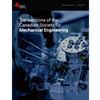A multibranch residual network for fault-diagnosis of bearings
IF 1
4区 工程技术
Q4 ENGINEERING, MECHANICAL
Transactions of The Canadian Society for Mechanical Engineering
Pub Date : 2022-05-03
DOI:10.1139/tcsme-2021-0107
引用次数: 1
Abstract
Time-frequency domain analysis methods are used to diagnose faults in bearings by extracting the features of fault signals. Given that a fault signal is also a form of audio signal, we extracted the characteristics of the mel spectrum from the original signal and applied it to a convolution neural network proposed in this paper. Focusing on the residual structure in the residual neural network (ResNet), we solved the gradient disappearance problem and accelerated the training of the model. The importance of each feature channel could be estimated adaptively using the squeeze-and-excitation network (SENet) considering the relationships between the channels. We examined the feature map of each layer using a multibranch residual network (MB-ResNet) to characterize the bearing fault signal. We used the multibranch residual structure to reduce the sense field of each residual and added a parallel local sensing module to train the model to recognize the weight of each input feature to either increase or reduce the influence of local features. Our experimental results show that the MB-ResNet is very good at extracting features, is robust, and capable of generalization.用于轴承故障诊断的多分支残差网络
通过提取故障信号的特征,采用时频域分析方法对轴承进行故障诊断。鉴于故障信号也是音频信号的一种形式,我们从原始信号中提取了mel频谱的特征,并将其应用于本文提出的卷积神经网络。针对残差神经网络(ResNet)中的残差结构,我们解决了梯度消失问题,并加快了模型的训练。考虑到通道之间的关系,可以使用挤压和激励网络(SENet)自适应地估计每个特征通道的重要性。我们使用多分支残差网络(MB-ResNet)来表征轴承故障信号,检查了每一层的特征图。我们使用多分支残差结构来减少每个残差的感测场,并添加了一个并行的局部感测模块来训练模型来识别每个输入特征的权重,以增加或减少局部特征的影响。实验结果表明,MB-ResNet具有很好的特征提取能力、鲁棒性和泛化能力。
本文章由计算机程序翻译,如有差异,请以英文原文为准。
求助全文
约1分钟内获得全文
求助全文
来源期刊
CiteScore
2.30
自引率
0.00%
发文量
53
审稿时长
5 months
期刊介绍:
Published since 1972, Transactions of the Canadian Society for Mechanical Engineering is a quarterly journal that publishes comprehensive research articles and notes in the broad field of mechanical engineering. New advances in energy systems, biomechanics, engineering analysis and design, environmental engineering, materials technology, advanced manufacturing, mechatronics, MEMS, nanotechnology, thermo-fluids engineering, and transportation systems are featured.

 求助内容:
求助内容: 应助结果提醒方式:
应助结果提醒方式:


